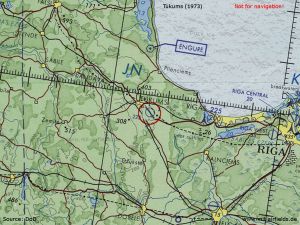Latvian SSR
Latvian Soviet Socialist Republic (Latvijas Padomju Sociālistiskā Republika/ Латвийская Советская Социалистическая Республика), was a Soviet Republic, located on the coasts of Baltic Sea.
History
It was first formed in the annexed Latvian Republic, following Stalin's ultimatum to the Baltic States in June of 1940. Despite Nazi occupation that lasted from the summer of 1941 to 1944, the Latvian Republic did not regain its independence after being reconquered by Soviets. It was one of the 15 republics of the Soviet Union, and remained so until the Singing Revolution of 1991, where Latvia alongside Lithuania and Estonia declared their independence.
Role in the Soviet Economy
Latvian SSR was the home of Rigas Autobus Factory (RAF / Rīgas Autobusu Fabrika). It was founded in 1949, and the said factory was located in Jelgava . While, many popular vehicles, such as RAF-251 or RAF-977 (appears as RF-977 in game) were manufactured in RAF, it's most notable model was RAF-2203, or as it appears in game - R-2203
While making no appearance in-game, Valsts Elektrotehniskā Fabrika (State Electrotechnical Factory) or VEF for short, was a electronics plant located in Riga, capital of Latvian SSR. Before Soviet Occupation it produced radios and aircraft, but afterwards became known for creating first ever portable shortwave receiver in USSR - Spīdola.
Another significant industrial complex was Liepājas Metalurgs, a metallurgy plant primarily focused on production of steel rods for construction purposes. Although it was founded as early as 1882, major production only began under Soviet Rule in 1960s. In 1978 statistics showed that the plant produced over 700'000 to 800'000 tonnes of steel products a year. After Baltic States regained their independence in 1990, Liepājas Metalurgs was nationalized by Latvian Republic, however was moved into the private market in 1997. During this period, Liepājas Metalurgs was one of the most advanced metallurgy plants in Europe. Sadly, Plant announced bankruptcy in 2016, following the aftermath of Economic Crisis of 2007. Even though it was purchased in 2016 by KVV Group, it failed to restart plan at full capacity. In 2019 nearly all technology - furnaces, rail cars etc. - were sold to the highest bidder. It is said that Liepājas Metalurgs provided nearly 8000 jobs for the citizens of Liepāja, and also supported sports clubs such as FK "Liepājas Metalurgs" and HK "Liepājas Metalurgs".
Sanatoriums
Latvian SSR was also known for its numerous Sanatoriums - medical facilities for long term illness patients, but also often acted as SPAs for high ranking Soviet citizens. Among those is Yuri Gagarin, who was rumored to often visit "Icarus Sanatorium" in Plieņciems. Some rumors also state that Viktor Tsoi, vocalist of Soviet Rock group "Kino" was visiting "Icarus" in 1990, shortly before he died in a fatal car accident mere 5 kilometers away from the Sanatorium, on Talsu - Jūrmala highway. There were also major Sanatorium Complexes in Ķemeri and Jūrmala. Most of these facilities are either abandoned or renovated these days, however a hefty part of Ķemeru Sanatorija was demolished. Vaivaru Sanatorium now is the National Rehabilitation Center of Latvian Republic.
Latvian SSR Role in Soviet Military
According to some reports, Tukuma Lidosta (Tukuma Air Base), know as Jūrmalas Lidosta these days, was a target of a nuclear strike in the case of a nuclear war. Reason behind was some reportedly factual intel that Tukuma Air Base housed nuclear weapons and the base itself could be used for Soviet bombers to rearm their nuclear payload. While there is no evidence available to confirm this, Air Base can indeed host just about any size bombers. According to one source, Tukums Air Base often stationed between 40 to 50 fighter jets, including even newer models that the West was not even aware of at the time. Today Tukuma Air Base serves as a commercial airport and can act as a back up if Riga International (RIX) is facing some technical issues.
 Hooded Horse Wikis
Hooded Horse Wikis


